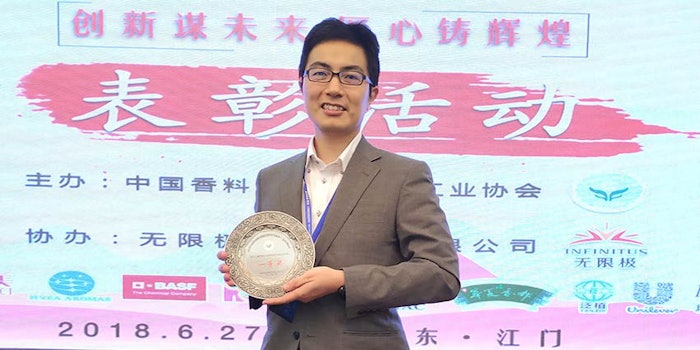
Shiseido took home three prizes at the 12th China Cosmetics Academic Research Conference. Hosted by the China Association of Fragrance, Flavour and Cosmetic Industries (CAFFCI) in Jiangmen, Guandong, China, the conference is held once every two years. Participants include companies, universities and research institutes from China and abroad. Research papers are selected based on “outstanding results that will contribute to advancing technologies in the Chinese cosmetics industry.”
Shiseido took home first prize and two second prizes for three research papers selected from 84 entries; to date, the company has taken home six first prizes at the conference. This year’s winning papers include:
First Prize
New Insights into the Development of Anti-aging Skincare Cosmetics Focusing on the Primary Causes of Wrinkles by Yusuke Hara, Shiseido Research Center—Body sites that are prone to wrinkling undergo a high degree of motion during facial expressions; therefore, skin motion may be an essential factor in wrinkle formation. Researchers confirmed an increase in wrinkle volume immediately after facial expressions. These resulting wrinkles were referred to as residual wrinkles, and the mechanically deteriorated stratum corneum (SC) was suggested to be primarily responsible for their formation.
An efficient method for repairing deteriorated SC was demonstrated to be the SC hydration–dehydration process, which could be controlled by skin care product ingredients or formulations. In Shiseido’s previous studies, polyoxyethylene/polyoxypropylene dimethyl ether was confirmed to enhance the SC hydration–dehydration process. It also suppressed the formation of residual wrinkles by keeping moderate moisture in the stratum corneum, and repaired the residual wrinkles formed. These results offer new insights into the development of daily anti-aging skin care cosmetics.
Second Prizes
Development of Breakthrough Anti-aging Skin Care—Discovery of a Critical Skin-aging Mechanism Caused by Sweat Gland Shrinkage: Dermal Cavitation by Tomonobu Ezure, Shiseido Research Center—To determine the cause of age-related skin sagging, Shiseido developed a new micro-computed tomography method to visualize internal skin structures in three dimensions, identifying for the first time that multiple defects are filled with adipose tissues (“dermal cavitation”) in the deep dermal layer of aged skin.
This research revealed that cavitation significantly decreases skin elasticity and promotes sagging, and that age-induced cavitation is closely connected with atrophic sweat glands. This further implies that sweat glands shrink upwards with aging and create cavities in the dermal layer, ultimately resulting in skin sagging. As for a means to improve cavitation, researchers identified, for the first time, that rosemary extract can attract adipose tissue-derived stem cells (ADSCs) and activate dermal tissues, establishing a three-dimensional dermal structure.
See related work: "Facial Fat as a Key Anti-aging Target."
A Novel Mechanism of Cutaneous Aging Mediated by the Impairment of Lymphatic Function and the Protective Role of a Lymphatic-promoting Compound by Kentaro Kajiya, Shiseido Research Center—Skin aging is thought to be caused partly by the deterioration of the inner body, particularly the circulatory system, which is composed of blood and lymphatic vessels. However, few studies have been conducted on the functions of lymphatic vessels in skin aging.
By visualizing the lymphatic vessels in the skin, Shiseido successfully revealed that:
1) Lymphatic vessels are functionally hyper-permeable in aged skin, deteriorating its autophagy functions of collecting waste products and excess water;
2) Sagging skin shows increased subcutaneous adipocyte accumulation and looser, hyper-permeable lymphatic vessel structure; and
3) Fatty acids in the lymph promote hyper-permeability of lymphatic vessels, leading to an increase in adipocyte accumulation.
Additionally, these researchers found an age-dependent down-regulation of Tie2 activation plays an important role in the stabilization of lymphatic vessels. Furthermore, cinnamon extract directly activates Tie2 receptor, promoting the stabilization of lymphatic vessels and controlling the accumulation of subcutaneous adipocytes.










